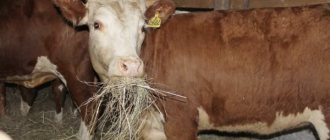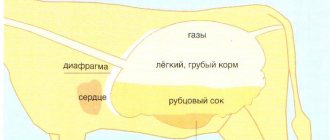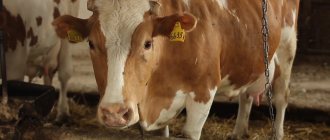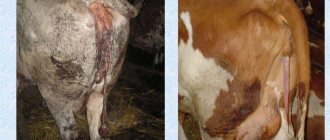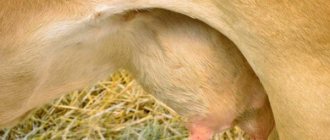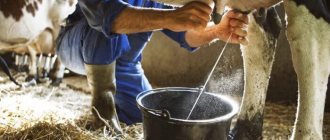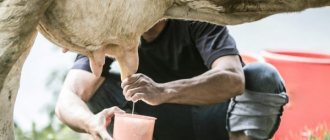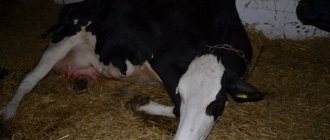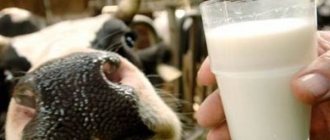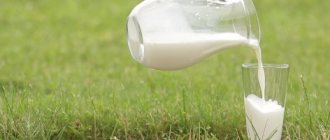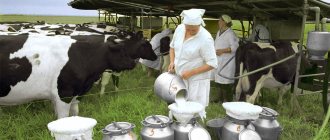Cows are ruminant animals. It seems that they are constantly eating and chewing, which is why they have such a large mass and size. In fact, this feature of cattle is due to the complex structure of the stomach. It consists of 4 chambers. In each chamber, a certain process of food breakdown and absorption of nutrients occurs. Chewing a cow's cud is not an easy process. What is it and why does it happen?
Features of digestion in cattle
The stomach of cows is complex. It's multi-chambered. The cow picks the grass and begins to chew it. The grass is partially crushed and moistened with saliva. It enters the rumen, where food is processed. It is affected by microorganisms, ciliates, and bacteria. The rumen muscles contract, mixing the food and further grinding it. A fermentation process occurs in the rumen, which is accompanied by the release of gas.
From the rumen, food enters the mesh. This is a filter that does not allow coarse food particles to pass through. Water and crushed food in the form of gruel enter the next section of the stomach - the book. Food that is not chopped well enough cannot go into the book. It returns back to the oral cavity. The cow burps.
In the oral cavity, coarse food particles are ground by the teeth. They are affected by saliva. In a crushed state, they again enter the rumen. If they do not pass through the mesh, the cycle repeats. This process of chewing food is called rumination or rumination.
The crushed food that has passed through the mesh enters the book. This is where the bolus of food is dehydrated. Nutrients and water are absorbed by the mucous membranes, which have the shape of sheets, which is why the stomach section is called a book.
From the book, food enters the abomasum, where it is acted upon by gastric juice. Further processing of the food bolus occurs in the intestines. This is where the nutrients necessary for the body are taken. The bolus of food moves further through the rectum to the anus, and comes out in the form of fecal matter.
The process of chewing gum is accompanied by the release of a large amount of saliva, up to 180 liters per day. It contains bicarbonate and sodium phosphate. Saliva not only helps to hydrate and break down food. It normalizes the pH balance in the scar part of the stomach. Rough feed stimulates saliva production. Juicy feeds and concentrates reduce its production.
The animals seem to be constantly chewing. Actually this is not true. Rumination has a certain cycle. It lasts 60 minutes. The portion of food that a cow burps is 120 g. Belching occurs 70 minutes after eating. There can be up to 16 rumination cycles per day. This is a complex process that is controlled by the central nervous system.
Atavisms of the structure
The ancient ancestors of cows were absolutely defenseless, because they did not know how to run fast or fight back, because they had neither fangs, nor claws, nor a developed musculoskeletal system. The ancestors of cows were apathetic, inactive and spent most of their lives lying in a shelter. The only way to survive in such a situation was the peculiar evolution of the animal’s gastrointestinal system.
The cow has a completely unusual stomach, which consists of 5 sections: rumen, mesh, book, abomasum and intestines. Such a stomach allowed and allows you to grab food, swallow it and leave without predators having time to catch it. And only then, in a safe place, did the cows begin to chew their food.
The mechanism of rumination
In the scar region and in the mesh, irritation of nerve receptors occurs. The impulse passes to the ruminant center, which is located in the brain. Next, excitement occurs in the center, a nerve impulse forces the animal to take a breath.
More on the topic: Peculiarities of feeding cattle in winter
- The diaphragm relaxes.
- The larynx is blocked.
- The esophagus opens. His walls relax. A food bolus from the mesh gets into it.
- The animal exhales.
- The esophagus closes. Rough food that comes from the mesh remains in the oral cavity. The cow begins to chew it.
- In this case, a small amount of liquid is formed in portions, which the animal drinks. Coarse particles are chewed for 60 seconds. A lump is formed from them, which the animal swallows.
The motility of the rumen is carried out under the influence of the vagus nerve, the chemical composition of food, and a certain form of feed. Excessive stretching of the scar walls inhibits motility. Slows down the disruption of acid-base balance.
The imbalance occurs due to an excess amount of light carbohydrates in the rumen. During the breakdown of food, large amounts of lactic and acetic acid are released. The belching reflex disappears. The chewing stops.
Lack of rumination is a sign of a violation of the digestive process in the gastrointestinal tract. In a small backyard it is easy to monitor the presence of chewing gum in animals. This is impossible to do in large livestock complexes. Scientists suggest using a special HR-Tag device. This is a transponder. It is hung around the animal's neck.
The device records the work of the rumen and transmits the data to the central computer. With its help, individuals who develop pathology are tracked, the reasons are analyzed: after feeding what kind of food, disturbances in the functioning of the rumen occurred. The animal is isolated. He is examined and prescribed certain therapy. The diet of the livestock is adjusted to avoid recurrent pathologies.
What if you don't chew?
Those who keep a cow on a farm know that an animal chewing cud is a good sign. A sick cow or one that is in a state of stress simply cannot chew food, which means that such an animal will not produce milk.
Failure of an animal's stomach to function can also be caused by ingestion of a sharp metal object, for example, nails or metal fragments. Such cases are very common and often lead to damage to the rumen and the cessation of gum formation. Without treatment, which is mostly done with tar, the animal dies of starvation.
Cows, being herbivores, are the main supplier of milk for all humanity. In fact, the history of the fact that cows’ domestic animals constantly chew “cud” goes back to the distant past, because in those distant times, many thousands of years ago, some animals could not quite successfully protect themselves from various predators, due to Thus, in the process of constant survival, in such a rather aggressive nature, such a special type of eating appeared, such as the fact that, having quickly satiated and swallowed food, the animals went to a safe place, where they could slowly chew food in a favorable environment for themselves. Thus, in the process of evolution, ruminants appeared, one of the species of which is the modern cow.
Acidosis
If a cow does not chew the cud, then this indicates a disorder in the stomach, namely in the ruminal region. What should be done? You should immediately contact a veterinarian. He will determine the reason for the cow’s lack of cud, provide first aid, and prescribe treatment.
If the herd was walked on a pasture with wheat, rye, barley, uncontrolled, then the animals could overeat plant food. Juicy grass is a light carbohydrate. Consumption of large amounts of grass from cereal plants leads to disruption of the pH in the rumen. The level of lactic acid begins to increase in it. Pathology develops when feeding large quantities of potatoes, beets, and melons. Animals show signs of acidosis:
- no chewing gum;
- no appetite;
- body temperature decreases;
- rapid breathing is noted;
- signs of tachycardia are detected;
- diarrhea develops;
- no urination.
If the animal is not helped in the first 24 hours, then the process of rotting will begin in the rumen. The cow's temperature rises, signs of dehydration are detected, and a process of increased gas formation occurs in the rumen. The abdomen increases in size. The animal is in pain.
- First aid consists of gastric lavage. 160 liters of water are injected through the probe. After 2 hours, an alkaline solution is injected through the probe. To do this, use sodium hydroxide: 60 g per 15 liters of warm water.
- They give IVs with saline solution.
- They use drugs to maintain the heart and restore rhythm.
On the day of treatment, animals are offered only hay. On day 2, the specific gravity of roughage should be at least 20%. Concentrates no more than 40%. They give Macerobacillin. These are enzymes for normalizing rumen and intestinal motility.
It is noted that cows most often suffer from acidosis during the transitional seasonal period. It must be taken into account that the transition period from winter to summer feeding lasts 15 days. During this time, animals are given a winter diet before walking. Walking is carried out in fields with small seedlings of cereal plants or on poor pastures with legumes.
Measures to prevent illness
To avoid problems, you should follow these rules:
- check the feed for the presence of foreign objects;
- reduce the amount of roughage;
- do not give calves large pieces of food;
- avoid overfeeding in cows;
- observe the rules of hygiene.
Loss of cud in a cow can be due to a variety of factors. Most often, various diseases lead to this problem. To cope with the problem, you need to make an accurate diagnosis.
Tympany
If the livestock was grazed on pastures with lush grass of alfalfa, clover, or in fields with corn, which is at milky-wax maturity, then there is a danger of overeating. Tympany may develop. Usually it is of a massive nature. The entire herd, which grazed in an area with good green vegetation, suffers.
More on the topic: Designs of milking machines for cows on farms
The grass is digested, releasing large amounts of gases. The walls of the scar stretch, the receptors lose sensitivity, and motor skills disappear. The stomach stops working. It is necessary to be attentive to animals that come after walking. If a cow doesn't chew the cud, what should I do? With tympany the following symptoms develop:
| № | Helpful information |
| 1 | lack of cud in a cow |
| 2 | her belly is getting bigger; the animal hits the body with its hooves, waves its tail, jumps, bows its head to the peritoneum |
| 3 | unnatural behavior appears: the cow lies down, but immediately gets up; moans, groans |
| 4 | after an hour, cyanosis of the mucous membranes is detected |
| 5 | tongue falls out |
| 6 | the animal breathes with its mouth open |
| 7 | veins swell: strong engorgement is noted |
Symptoms develop quickly. If a cow is diagnosed with tympany, then she is given first aid. The animal is positioned so that the head is higher than the pelvic part. Gases must be removed from the rumen. This is done using a probe. The scar is pierced with a needle and a gas outlet tube is inserted. They massage the scar. After the volume has decreased and the gases have escaped, treatment begins.
- Reduces the fermentation process. To do this, one of the solutions is injected into the stomach through a probe: ichthyol 20 g, formalin 15 g. The substances are mixed with 2 liters of water.
- A puncture is made in the area of the left hungry fossa, gases are released and “Tympanol”, “Tar”, “Creolin” are injected through a probe.
- Calves are given a solution of hydrochloric acid: 10 ml per 500 ml of water. Gastric juice is administered: 50 ml per 500 ml of water. The rumen microflora from a healthy animal is inoculated. Treatment is continued for 14 days.
Calves that are switched from dairy to plant foods are susceptible to tympania. At risk are young animals that go out to pasture for the first time. It is necessary to limit the walking time for calves to 3 hours. Grazing is carried out on a very sparse field. Before grazing, calves are given hay. If they lose their chewing gum after walking, they begin immediate treatment.
